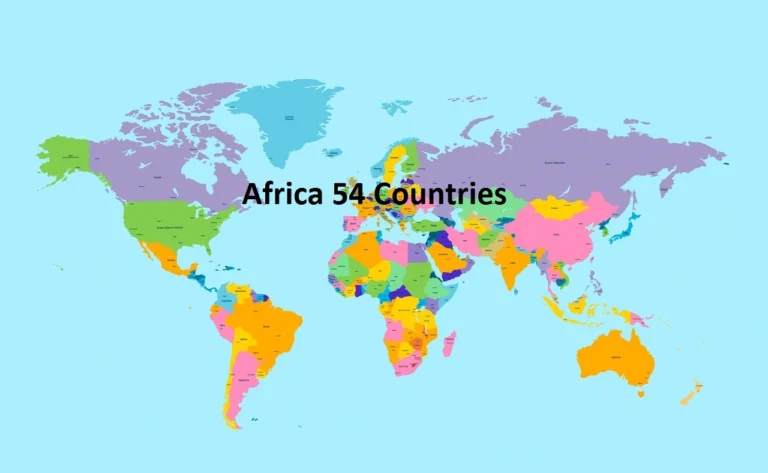Africa is the Continent which has the most number of countries, it has 54 recognized sovereign states.
Africa is a diverse and fascinating continent known for its history, culture, and beautiful scenery.
Africa has 54 countries and over 1.3 billion people second largest population after Asia.
The continent speaks thousands of languages and has a young population.
Africa: The Continent with the Most Countries
Africa, the second-largest continent on the planet, takes the spotlight as the continent with the most countries.
This vast and diverse landmass is home to 54 recognized sovereign states.
From the northern shores of Algeria to the southern tip of South Africa, Africa’s political map is a mosaic of nations, each with its unique identity, culture, and language.
Table: 54 Countries of Africa Continent:
| Northern Africa | Western Africa | Eastern Africa | Central Africa | Southern Africa |
|---|---|---|---|---|
| Algeria | Benin | Burundi | Angola | Botswana |
| Egypt | Burkina Faso | Comoros | Cameroon | Eswatini (Swaziland) |
| Libya | Cape Verde | Djibouti | Central African Republic (CAR) | Lesotho |
| Mauritania | Ivory Coast | Eritrea | Chad | Malawi |
| Morocco | Gambia | Ethiopia | Congo, Republic of the | Mozambique |
| Sudan | Ghana | Kenya | Congo, Democratic Republic of the (DRC) | Namibia |
| Tunisia | Guinea | Madagascar | Equatorial Guinea | South Africa |
| Guinea-Bissau | Malawi | Gabon | Zambia | |
| Liberia | Mauritius | Sao Tome and Principe | Zimbabwe | |
| Mali | Rwanda | |||
| Niger | Seychelles | |||
| Nigeria | Somalia | |||
| Senegal | South Sudan | |||
| Sierra Leone | Tanzania | |||
| Togo | Uganda |
1. Africa’s Language Diversity:
One of Africa’s most remarkable features is its unparalleled linguistic diversity. With over 2,000 languages spoken across the continent, Africa stands as the world’s linguistic giant.
The languages of Africa belong to several distinct language families, including Afroasiatic, Niger-Congo, Nilo-Saharan, and Khoisan.
2. Africa’s Vibrant Culture:
Africa is renowned for its cultural richness, with each country exuding its distinct traditions, music, dance, art, and cuisine.
From the ancient wonders of Egypt to the vibrant rhythms of West Africa and the intricate beadwork of the Maasai in East Africa, the continent’s cultural tapestry is a source of wonder and inspiration.
3. Economic Landscape:
Africa’s economic landscape is as diverse as its cultural heritage. Some African countries have experienced significant economic growth, while others face challenges like poverty and underdevelopment.
The continent’s economy is based on various sectors, including agriculture, mining, manufacturing, and services. Africa is also rich in natural resources, such as oil, minerals, timber, and agricultural products.
4. Africa and Other Continents:
Africa:
- Population: Over 1.3 billion people
- Area: 30.2 million square kilometers
- Percentage of world population: 16.6%
Other Continents:
- Asia: Population – 4.6 billion (58.1%)
- Europe: Population – 746 million (9.5%)
- North America: Population – 579 million (7.3%)
- South America: Population – 430 million (5.4%)
- Australia: Population – 41 million (0.5%)
| Continent | Number of Countries | Population (Approx.) | % of World Population |
|---|---|---|---|
| Africa | 54 | 1.3 billion | 16.6% |
| Asia | 48 | 4.6 billion | 58.1% |
| Europe | 44 | 746 million | 9.5% |
| North America | 23 | 579 million | 7.3% |
| South America | 12 | 430 million | 5.4% |
| Australia | 14 | 41 million | 0.5% |
Also Read: India Lies in Which Continent
Conclusion:
Africa, the continent with the most countries, is a land of rich heritage, cultural diversity, and vast economic potential.
With 54 recognized sovereign states, it stands as a testament to the resilience and diversity of its people.
As we explore the world’s continents, we discover that each holds its unique allure, contributing to the magnificent tapestry of our planet’s diversity.




